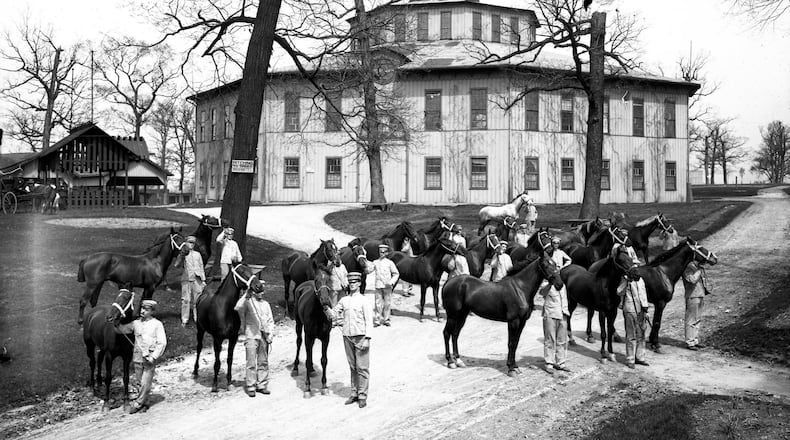Thousands and thousands of Daytonians and visitors have walked through the Agricultural Building AKA “The Roundhouse.”
The former fairgrounds property along South Main Street is owned by University of Dayton and Premier Health. Their joint venture to redevelop the property is called “onMain: Dayton’s Imagination District,” and plans call for The Roundhouse to be preserved and incorporated into the neighborhood’s open spaces.
Few can deny that the Roundhouse is a Dayton landmark, but how much do you know about it?
Below are 7 facts about the building you may not know.
NOTHING ROUND ABOUT THIS ROUNDHOUSE
Credit: Lisa Powell
Credit: Lisa Powell
“The Exposition Hall” was designed in 1874 by Dayton architect and contractor Leon Beaver.
It was completed in 1874 for $8,400.
It was ordered as a “round” house, but the building evolved into the eight-side building of today, according to a 1953 Journal Herald article.
It is not clear exactly why the roundhouse became an octagon, but Victorian author Orson Squire Fowler promoted the octagon as an alternative to the rectangular shape because it allows more room, according to Fairground record.
Octagon houses were popular in Ohio between 1850 to 1870 on the heels of Fowler’s 1848 book, “A Home for All.”
Some farmers started using octagon-shaped barns for livestock and dairy cows.
Most of Ohio’s octagonal barns were built between 1875 and 1900, according to information in the fairground’s files.
CONFETTI, CONFETTI EVERYWHERE
Credit: Photo: Amelia Robinson
Credit: Photo: Amelia Robinson
They say you can never really get rid of confetti.
The Roundhouse proves that.
AIDS Resource Center Ohio (now Equitas Health) held several of its confetti-filed annual Masquerage parties in the roundhouse.
Spencer pointed out confetti from one of the first Masquerage events in the rafters, on beams and in Japanese lighting dangling from the ceiling.
Credit: Peter Wine
Credit: Peter Wine
Credit: Photo: Amelia Robinson
Credit: Photo: Amelia Robinson
MAJOR OVERHAUL IN 1953
Credit: Photo: Amelia Robinson
Credit: Photo: Amelia Robinson
The 1953 reconstruction of the Roundhouse paid tribute to Ralph C. Haines, the secretary-manager and director of the Montgomery County agricultural board.
It was rededicated Sept. 7, 1953, in his memory.
The $55,000 overhaul included cement floors and a maple floor on the second level.
“Wooden beams were replaced with steel, and noise-proof ceilings were put in and the ‘long haul’ stairways to the second floor entirely rebuilt,” according to the Journal Herald article.
HIT BY BLIZZARD
Credit: Photo: Amelia Robinson
Credit: Photo: Amelia Robinson
Weather has not always been a friend to the Roundhouse.
Spencer pointed out repairs to the roof made due to a lightning strike.
More than $23,886 in repairs were made after a portion of the roof collapsed during heavy snowfall from the 1978 Great Blizzard, according to Montgomery County agricultural records.
>>PHOTOS: A look back at the Blizzard of 1978
Credit: Photo: Amelia Robinson
Credit: Photo: Amelia Robinson
SHOWROOM
When the fair wasn’t going on, the Roundhouse held A.B. Hallum furniture store.
The heated store was owned by Andrew Bradley Hallum, an “always impeccably” dressed graduate of Harvard Business School and Iowa State University, where he studied agriculture.
Hallum died in 1992, according to his obituary.
Mr. Hallum called himself "tight" with money and liked to demonstrate it by turning out the lights in areas of his showroom where nobody was inspecting the furniture.
Hallum owned furniture in Dayton for 57 years.
AN UNEQUALLY HISTORICAL PLACE
Credit: Photo: Amelia Robinson
Credit: Photo: Amelia Robinson
The Roundhouse was added to the National Register of Historic Places in 2003.
The building hailed as “magnificent” by the 1882 “History of Montgomery County,” was noted in the application as the largest of five still surviving eight-sided halls constructed in Ohio between 1871 and 1889.
>>PHOTOS: Montgomery County Fair, a Dayton tradition since 1856
GOLDSMITH MAID RIDES
Credit: Photo: Amelia Robinson
Credit: Photo: Amelia Robinson
A Dayton resident raised $15,000 in 1873 in the hopes that the state fair would be staged here, according to a Dec. 28, 1930, article republished by Dayton History Online.
The fair instead went to Columbus.
Daytonians decided to hold their own fair.
The fairgrounds’ first fair started Sept. 29, 1874, and was “heralded as the Southern Ohio fair.”
Thousands showed up to see the horse Goldsmith Maid, the "Queen of the Trotters."
More than 125,000 people paid to attend the fair during its five days.
The Roundhouse can be seen in the distance in an illustration of the day Goldsmith set a world record for the half-mile track.
About the Author









